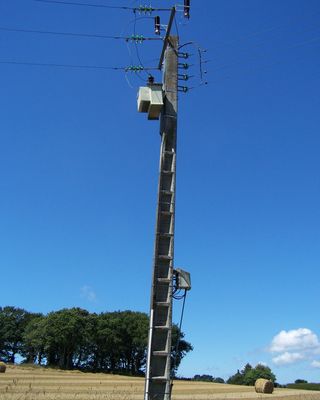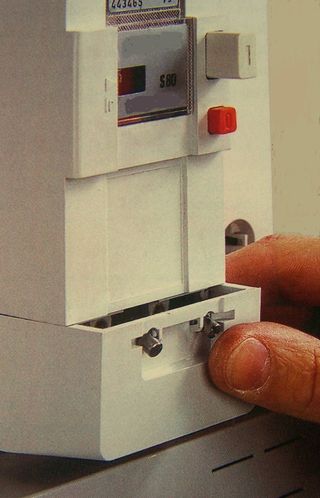Anyone buying a house in France will be fascinated by the interesting electrical supply methodology and in particular the house wiring compared to the UK. Anyone with a basic understanding of domestic electrical wiring will probably be horrified at the initial look at a typical French electrical system compared to that of the UK standards. In reality the French system is fairly robust and providing it is a fairly new installation unlikely to give you many problems. Without getting into the technicalities of electrics I thought it might be helpful to point out some of the key differences for those who have just, or are about to buy a French house.
Unless you live in a town it is likely that your supply will be delivered by overhead lines which snake their way through the countryside.
It is these lines which are often struck during thunder storms causing an electrical surge in the supply. Most installations will have two safety devices to prevent damage to the house wiring system:
1. A surge/short circuit protector on the mains master switch with a reset button.
2. A surge/short circuit protector in the distribution panel with a reset switch.
It a good idea to let the storm pass before resetting the system otherwise you may have to do it more than once. The electricity companies try their best to prevent the surges reaching the domestic supply by installing long earthing cables under ground, usually next to the local transformer boxes. These are designed to dissipate the power surge but in practice they tend to make little difference.
In the UK it is not unusual to see pole transformers (Reducing transmission voltage down to local domestic voltage) in the local areas similar to the ones in France but one noticeable difference is the

older ones are installed in a brick tower looking like small watch towers. The modern ones are similar to those found in the rural areas of the UK with a transformer fitted to the side of a pole,as seen in the picture to the left.
If you are buying a house in France it is a good idea to ask what the power rating of the supply is to the property as the basic tariff is based on the Amperage of the supply rating. This can vary dependant on the occupation and use of the dwelling, i.e. a house used as holiday accommodation with limited electrical fittings may have a supply as low as 15A, whereas a house occupied by a family with lots of electrical appliances and perhaps electrical radiators would need at least 45A.
If you tried to use a lot of electrical appliances at once in a house with a minimal supply the power switch would trip cutting the power as you were exceeding the fusible rating, we know we tried it! Increasing the power supply rating is not usually a problem, but it is worth checking with the supply company if you are thinking of buying a property in a very remote area.
You can actually complete a calculation by adding up the various electrical demands of every appliance but it is far easier to ask the advice of the power supplier in your area, who will estimate the Amperes requirements for you.
Although the supply comes in overhead cables it is possible to have the last part of the supply run underground,i.e. the supply from the nearest pole to the interior of the house. Not only is this preferable in terms of visual appearance but also a lot safer if you want to work on roofs near the supply cable attachments. It is worth remembering that everything to the house side of the meter is the house owners responsibility and everything the other side is the responsibility of the power company. So if you have a meter installed at the boundary to your property all the cabling from there to the house is your responsibility.
Meter reading can be a problem if you are absent from the house a lot and cannot arrange entry. In these circumstances it is a good idea to have an external meter reading point fitted,these are unobtrusive small beige coloured units placed on an accessible external wall. There is a cost for the installation. Meter reading is normally only carried out every 6 months the intervening readings being estimated.
Upon initial inspection the house wiring looks similar to that of the UK and most modern systems will have a fuse board with resettable fuses rather than the old wired fuses. However it is in the hidden areas that the similarities finish.
 On modern French systems the main fuse is replaced with a surge protector which has two buttons one large white and one small red. The red button can be depressed in the event of a problem to cut the supply. In the event of a surge the power is cut and the white button has to be pressed to reset the system.
On modern French systems the main fuse is replaced with a surge protector which has two buttons one large white and one small red. The red button can be depressed in the event of a problem to cut the supply. In the event of a surge the power is cut and the white button has to be pressed to reset the system.
Meters are likely to be either the old revolving wheel type with a mechanically driven readout or a modern digital format with are far easier to read. As with the UK, day and night usage is charged at a different rate. It is possible that you will come across a tariff called 'Tempo' which involves the division of electrical usage into 6 different usage rates, red,blue & white,plus the day and night usage on each. This tariff was principally supplied to second homes where usage was minimal and inconsistent, however my understanding is this is now unavailable to new subscribers.
The majority of house wiring is completed using single cable methodology running within cable protective tubing to protect it from rodent attack. e.g. a simple plug would have three separate cables rather than one PVC covered cable At various points throughout the house terminal boxes are installed to act as junctions for the myriad of cables servicing the electrical system. The majority of the electrical system is designed around spurs with up to eight outlets per spur.
The spurs will originate from a fuse block which is divided into what the French call divisions, each division being protected by a safety cut out called a 'disjoncteur' . If you loose power suddenly it is worth checking these in the first instance to see if one of these has operated and of course trying to identify the fault before resetting.
Obviously the sockets and plugs are different than the UK and its fascinating to see how various 'expats' get around the problem of having appliances with UK plugs. Some take the sensible approach and change all the plugs to the European standard, others prefer to treat it as an economical challenge! I have seen plug converters, multi socket UK adapters with one European plug and the worst of all, changing all the wall plugs for UK design. This has to be madness as it is probably not legal and they would all have to be changed if the house was ever put up for sale. The most important reason for not installing UK plugs is the consideration that insurance companies would use it as a reason not to pay out in case of a fire.
It goes without saying that all electrical work should be carried out by a qualified electrician and all new installations require their certification.
Recent Comments